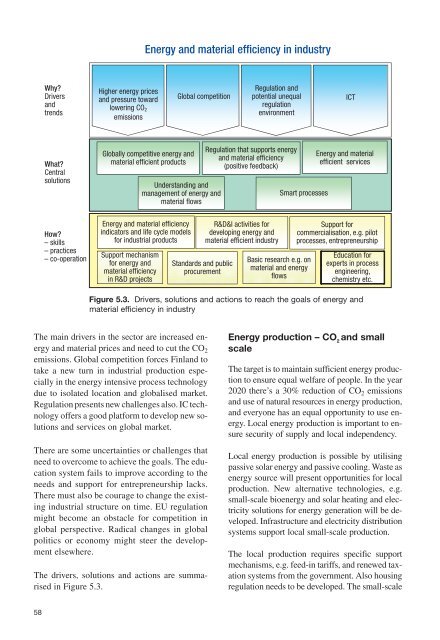227/08 Social challanges s the basis for foresight - Gaia
227/08 Social challanges s the basis for foresight - Gaia
227/08 Social challanges s the basis for foresight - Gaia
Create successful ePaper yourself
Turn your PDF publications into a flip-book with our unique Google optimized e-Paper software.
The main drivers in <strong>the</strong> sector are increased energy<br />
and material prices and need to cut <strong>the</strong> CO 2<br />
emissions. Global competition <strong>for</strong>ces Finland to<br />
take a new turn in industrial production especially<br />
in <strong>the</strong> energy intensive process technology<br />
due to isolated location and globalised market.<br />
Regulation presents new challenges also. IC technology<br />
offers a good plat<strong>for</strong>m to develop new solutions<br />
and services on global market.<br />
There are some uncertainties or challenges that<br />
need to overcome to achieve <strong>the</strong> goals. The education<br />
system fails to improve according to <strong>the</strong><br />
needs and support <strong>for</strong> entrepreneurship lacks.<br />
There must also be courage to change <strong>the</strong> existing<br />
industrial structure on time. EU regulation<br />
might become an obstacle <strong>for</strong> competition in<br />
global perspective. Radical changes in global<br />
politics or economy might steer <strong>the</strong> development<br />
elsewhere.<br />
The drivers, solutions and actions are summarised<br />
in Figure 5.3.<br />
58<br />
Why?<br />
Drivers<br />
and<br />
trends<br />
What?<br />
Central<br />
solutions<br />
How?<br />
– skills<br />
– practices<br />
– co-operation<br />
Higher energy prices<br />
and pressure toward<br />
lowering CO2<br />
emissions<br />
Energy and material efficiency in industry<br />
Globally competitive energy and<br />
material efficient products<br />
Understanding and<br />
management of energy and<br />
material flows<br />
Energy and material efficiency<br />
indicators and life cycle models<br />
<strong>for</strong> industrial products<br />
Support mechanism<br />
<strong>for</strong> energy and<br />
material efficiency<br />
in R&D projects<br />
Global competition<br />
Standards and public<br />
procurement<br />
Regulation and<br />
potential unequal<br />
regulation<br />
environment<br />
Regulation that supports energy<br />
and material efficiency<br />
(positive feedback)<br />
R&D&I activities <strong>for</strong><br />
developing energy and<br />
material efficient industry<br />
Smart processes<br />
Basic research e.g. on<br />
material and energy<br />
flows<br />
ICT<br />
Energy and material<br />
efficient services<br />
Support <strong>for</strong><br />
commercialisation, e.g. pilot<br />
processes, entrepreneurship<br />
Education <strong>for</strong><br />
experts in process<br />
engineering,<br />
chemistry etc.<br />
Figure 5.3. Drivers, solutions and actions to reach <strong>the</strong> goals of energy and<br />
material efficiency in industry<br />
Energy production – CO 2 and small<br />
scale<br />
The target is to maintain sufficient energy production<br />
to ensure equal welfare of people. In <strong>the</strong> year<br />
2020 <strong>the</strong>re’s a 30% reduction of CO 2 emissions<br />
and use of natural resources in energy production,<br />
and everyone has an equal opportunity to use energy.<br />
Local energy production is important to ensure<br />
security of supply and local independency.<br />
Local energy production is possible by utilising<br />
passive solar energy and passive cooling. Waste as<br />
energy source will present opportunities <strong>for</strong> local<br />
production. New alternative technologies, e.g.<br />
small-scale bioenergy and solar heating and electricity<br />
solutions <strong>for</strong> energy generation will be developed.<br />
Infrastructure and electricity distribution<br />
systems support local small-scale production.<br />
The local production requires specific support<br />
mechanisms, e.g. feed-in tariffs, and renewed taxation<br />
systems from <strong>the</strong> government. Also housing<br />
regulation needs to be developed. The small-scale









